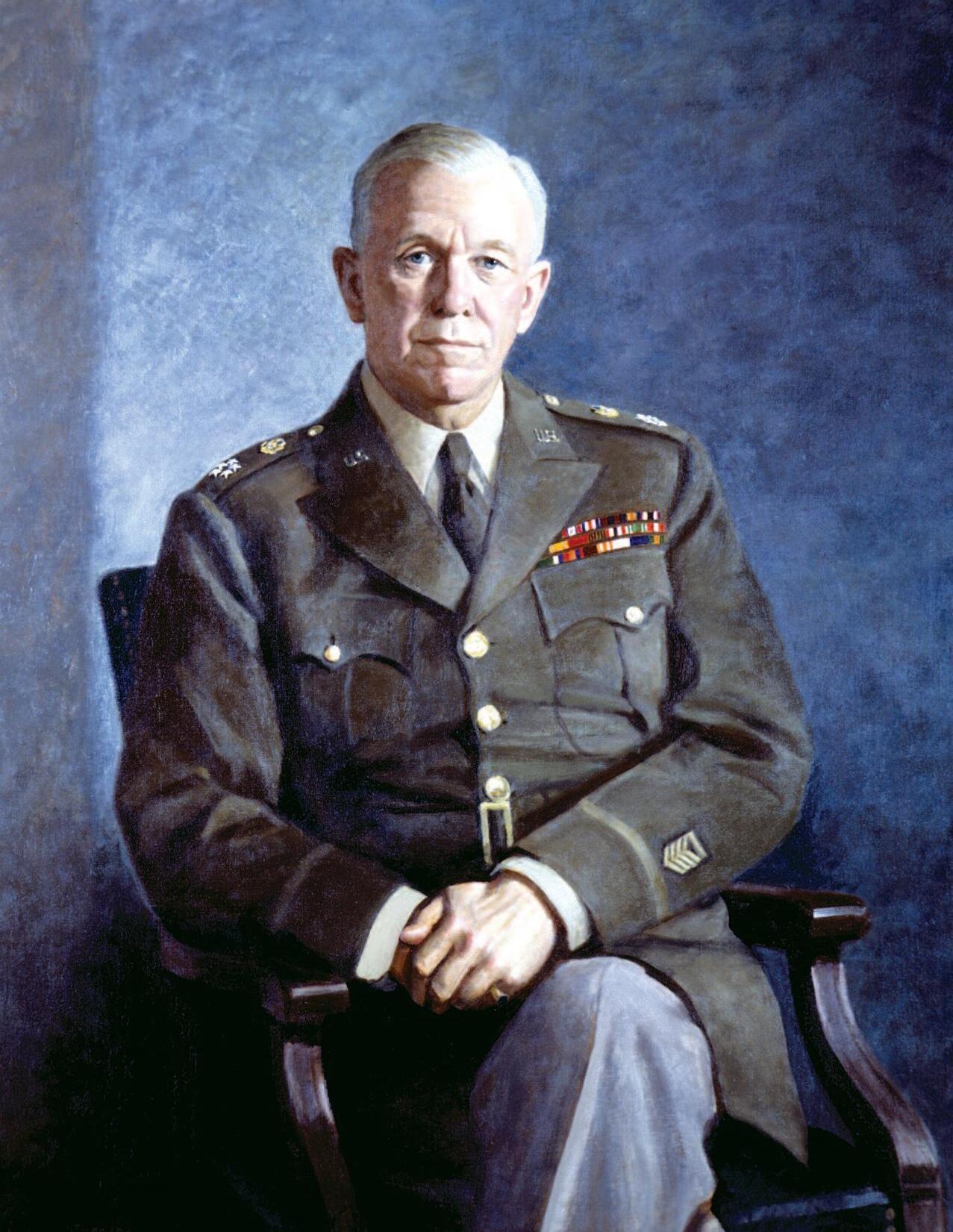George C. Marshall: Global Commander
BY F O R R E S T C. P O G U E, P H.D.


Clearly, General George C. Marshall was the first American general to be truly a global commander. As [U.S. Army] Chief of Staff, he commanded ground and air forces which at the end of the war in Europe numbered some 8 1/3 million men in nine theaters scattered around the world.
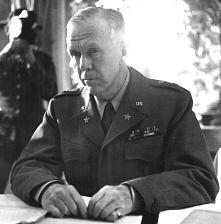
At the time of Pearl Harbor, Marshall's only important garrisons outside the continental United States were in the Philippines and Hawaii A few months later, he had troops moving to the Hawaiian C ommand, now commanded by airman Lt. Gen. Delos Emmons, for support of operations in the Pacific.
Marsha l l had app ointe d G en. D oug l as MacAr t hur as commander of t he Southwest Pacific eater and arranged for him to be named as commander of the Australian forces as well. To head Army and Army Air Forces in the S outh Pacific, he named Gen. “Hap” Arnold's Chief of the Air Staff, Maj. Gen Millard F Harmon, brother of the distinguished general for whom this series of lectures is named. Air units and ser vice troops were also on their way to India, Burma, and China, where Gen. Joseph Stilwell was to command. An air force was also set up in the Middle E ast.
One mor ning in 1944, G enera l Marsha l l inv ite d t he repres ent at ive of a commander w ho b elie ve d t hat his theater was being neglected to attend a morning briefing in his office In accordance with the usual custom, the officers charged wit h t his duty had placed on t he map t he pins show ing t he prog ress on t he different ac t ive fronts of the world At a glance one could see that fighting was rag ing in It a ly, in nor t hwest and s out her n France, on the Ledo Road, in the air against Germany and the possessions of Japan, or in the widely s cattered islands of t he Pacific. e Chief of St aff was amus ed as he s aw his visitor s growing realization of the many fronts the War Department had to arm and supply
No other Chief of Staff in Great Britain or the United States carried a heavier burden in dealing with legislative bodies, the Press, state executives, and makers of public opinion
In addition to his normal duties as Army Chief, Marshall had important special responsibilities. In 1941, he became the only militar y member of the high polic y committee dealing with the
is article has been excerpted from the Harmon Memorial Lecture delivered by Dr Pogue at the U S Air Force Academy in 1968 when he was director of the Marshall Librar y e full text of the lecture is available on our website
5 4 M A R S H A L L F O U N D A T O N O R G F A L L 2 0 1 7
p h o t o c r e d t G e o r g e C M a r s h a l R e s e a r c h L i b r a r y
General Marsha l at the Potsdam Conference in July 1945

General Marshall with Chiefs of the War Dept in March 1942: LTG Henr y H Arnold (seated eft) and LTG Lesley J McNa r (seated right) with MG Joseph T McNarney (stand ng left ) and MG Brehon Somer ve l Marshall s world v ew began to broaden during his first ass gnment n the Phi ipp nes n 1902-03
atomic bomb project
L ater, when implementation of the project was placed under Maj Gen Leslie Groves, that officer was made directly responsible to S ecretar y of War Stimson and to General Marshall.
G enera l Marsha l l s er ve d as t he exe c ut ive of t he C ombine d C hiefs of St aff in g iv ing dire c t ives to G en Eis en hower w hi le he was A l lie d Commander in the Mediterranean and, later, when he became Supreme Allied C ommander in northwest Europe. He also represented the Joint C hiefs of St aff in de a ling wit h G enera l MacAr t hur in t he S out hwest Pacific and General Joseph Stilwell in the China Burma-India eater.
No other Chief of Staff in Great Britain or the United States carried a heavier burden in dealing with legislative bodies, the Press, state executives, and makers of public opinion In frequent appearances on Capitol Hill, he gained votes for appropriations and for huge increases in manpower. His support helped to pass the first selective ser vice legislation, aer it had been brought for ward by civilian leaders and bipartisan groups in C ongress In 1941, it was his strong appeal to a handful of members of the Lower House that secured the margin of one vote in the House of Representatives for the extension of the dra four months before Pearl Harbor.
Marshall found that his task did not end with obtaining appropriations and the men he needed E arly in his term as Chief of Staff he discovered that business leaders were distant to White Hous e demands for incre as e d war pro duc t ion and suspicious of Mr. Ro os e velt's prop os a ls. Using the same frank approach to the Business Advisor y C ouncil that he had used to C ongress, he gained greater business cooperation in meeting the Army s needs.
“I wish above everything that I could feel that my time was to be occupied in sound development work rather than in meeting the emergencies of a great catastrophe.”
is tremendous spreading of his time and energies was not to his liking. He had written an old friend soon aer becoming Chief of Staff, “I wish above ever ything that I could feel that my time was to be occupied in sound development work rather than in meeting the emergencies of a great catastrophe.” But he was to spend his long term of slightly more than six years as Chief of Staff in struggling to prepare the Army and Army Air Forces for their duties in a global war Sworn in a few hours aer Hitler’s army invaded Poland, he remained at his p ost unt i l t he war was finishe d and demobilization had b egun. With the except ion of Marsha l St a lin and t he Jap anes e emp eror, Marsha l l was t he on ly war t ime le ader to ret ain t he s ame p osit ion for t his ent ire p er io d. (Arnold, while chief of the Air C orps in S eptemb er 1938, did not b e come C ommanding G enera l of t he Ar my Air Forces and a member of the Joint Chiefs of Staff until 1942.)

At the war ’ s close, the British Chiefs of Staff, Field Marshal Lord Alanbrooke, Admiral of the Fleet Lord Cunningham of Hyndhope, and Marshal of the Royal Air Force Lord Portal, who had ser ved with Marshall during much of the conflict, hailed him as “architect and builder of the finest and most powerful Army in American histor y. ” Prime Minister Winston Churchill spoke of him as “the organizer of victor y ” Marshall s old friend, B ernard Baruch, called him the first global strategist
What were the roads he followed to reach this end? In his first tour in the Philippines, Marshall gaine d his init i a l ide as of Amer ic a ' s g lob a l resp onsibi lit ies At t he s ame t ime he st r ug g le d through the necessarily painful process of learning how to command e Philippine Insurrection had just ended and the volunteer officers who had ser ved in the recent war and the ensuing fighting in the Islands were going home. As a result of the shortage of Regular Army officers, Marshall found himself a few months aer arrival as the only officer in charge of a company in the southern half of the island of Mindoro. With little training to guide him, with no manual on how to deal with occupied territor y, cut off from the outside world except for the monthly visit of a small supply boat, he fell back on what “the C orps, the [Virginia Militar y] Institute, expected of a cadet officer in the performance of his duty.” He was green in militar y affairs, but he got by, as he recalled, with “the super-confidence of a recent cadet officer” and the help of two seasoned sergeants
Par ticipants in the A lied Planning Conference that took place at the A lied Force Headquar ters (AFHQ) n A giers n June 1943 include (from eft to right): British Foreign Secretar y Anthony Eden General A an Brooke Air Chief Marsha Ar thur Tedder, Admiral Andrew Cunningham General Harold A exander General Marsha l General Dwight Eisenhower and General Bernard Montgomer y with Prime Minister Winston Church ll (seated in the center)
Col Marshal and MG Henr y T Al en w th the 8th Corps n France during World War

e young officer, returned to the United States aer 18 months in the Islands, could never again take a wholly narrow view of the world.
A lt houg h he wou ld not retur n to foreig n dut y for more t han a de c ade, he k ne w t hat Amer ic an interests l ay b e yond rest r ic te d boundaries. Indeed, his career was to parallel almost exactly the first 50 years of the twentieth centur y as the tasks of the United States Army grew and as the United States expanded its global role
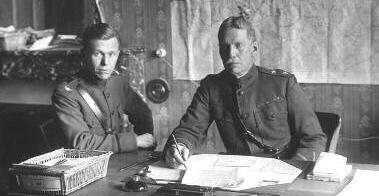
Grow ing Jap anes e ag g ressiveness wor r ie d t he sma l l Ar my force in t he Phi lippines dur ing Marshall's second tour He and his colleagues became involved in exercises designed to test the ability of an unnamed enemy to overrun the Islands. In 1914, the sudden illness of the officer charge d w it h ac t ing as chief of st aff of t he “ enemy ” l anding force in s out her n Luzon gave
7 6 M A R S H A L L F O U N D A T O N O R G F A L L 2 0 1 7
p h o t o c r e d i t G e o r g e C M a r s h a l l R e s e a c h L b r a r y
p h o t o c r e d t G e o g e C M a r s h a l R e s e a r c h L b r a r y p h o t o c r e d i t G e o r g e C M a r s h a l l R e s e a c h L b r a r y p h o t o c r e d t G e o g e C M a r s h a l R e s e a r c h L b r a r y

Marshall (center) ser ved as execut ve officer with the F fteenth Infantr y Regiment n T ents n, China from Sept 1924 through May 1927
Lt Marshall his big chance to show his ability as a staff officer Stepping into a role for which he had rehearsed in maneuvers in C onnecticut, Pennsylvania, New York, and Texas, only a few years b efore, he gaine d a reput at ion for genius with battle plans that would be exag gerate d in t he tel ling One w ho watched him in those exciting days was young Lt. “Hap” Ar nold. O bs er v ing Marsha l l dic t ate a field order w it h nothing but a map before him, Arnold told his wife that he had seen a future chief of staff of the Army
Marshall was to have one more experience with duty in the Far E ast before World War II. In the years between the great wars, he asked for duty in China. From 1924 to 1927, he ser ved in Tientsin as Executive Officer of the 15th Regiment, which was charged with the duty of helping other foreign powers keep open the railroad from Peking to the sea Le in command on two occasions when warring factions threatened to overrun the American sector, he managed by quiet firmness and persuasion to tum the marauders aside from the city.
Newsmen referred to him as a “wizard” and Gen. Pershing in his memoirs singled out his contributions for special praise.…
“The troops which maneuvered under his plans always won. ”
Although his mental horizons were immeasurably widened by the three tours he sp ent in the Far E ast, Marshall perhaps gained most in his global outlook by his two years in France from the summer of 1917 to the fall of 1919. A memb er of the first division to go to France, training officer and then chief of operations of the 1st Division, he advanced to a planning assignment at Pershing's General Headquarters at Chaumont, and then to the post of chief of operations of Gen. Hunter Liggett’s First Army in the closing weeks of the war. In one of his later assignments, he helped plan the operation at St Mihiel en, while that battle was still in progress, he was shied to super vising the moving of units into the Meuse-Argonne area for the final United States offensive of the war. is task, which required the orderly withdrawal from the line of French and Italian units and moving in over three main roads troops from the St Mihiel front and other areas, approximately 800,000 men, brought into play his logistical talents Newsmen referred to him as a “wizard” and Gen. Pershing in his memoirs singled out his contributions for special praise A member of Pershing’s staff later wrote that Marshall’s task at First Army was “to work out all the details of the operations, putting them in a clear, workable order which could be understood by the commanders of all subordinate units. e order must be comprehensive but not involved. It must appear clear when read in a poor light, in the mud and the rain. at was Marshall’s job and he performed it 100% e troops which maneuvered under his plans always won ”
Marshall’s rise in the Army was greatly assisted by his work in France, and his later leadership as Chief of Staff was strongly influenced by what he obser ved in World War I. He recalled the


shocked faces of the French when they saw the almost total unprep are dness of t he first Amer ic an t ro ops s ent to France. Un li ke many of his col le agues, most of whom arrived later when trained Amer ic an units showe d up wel l a longside we ar y, b att le wor n French cont ingents, he understo o d French res er vat ions ab out fig ht ing qu a lit ies of Amer ic an troops and was patient with their unfavorable re ac t ions. He retur ne d to t he Unite d St ates determined, if he had anything to do ab out it, ne ver to let anot her Ar my go abro ad unt i l it was prepared to fight
S everal other lessons stayed with him. He recalled that there had been no proper siing out of officers before the units came overseas and that Pershing at one time had thirty or more general officers on the road to the rear for reassignment. He was angered when he found a lack of concern for fighting men by t he S er v ices of Supply. Told t hat items such as candy and small necessities would b e available by purchase only through post exchanges, he protested When the Chief of Staff of First Army chided him about his remarks, he angrily exclaimed, “By God, I won t stay as G-3 if the man at the front can’t have these things I don’t favor sending men up to die if I can’t give them a free box of matches ” He fumed because recognition of braver y was long delayed, insisting that the value of medals and battlefield promotions lay in prompt recognition of performance so that other men could see that fine qualities of leadership and valor were appreciated by the Army. He was furious when red tape in the rear areas made unnecessarily difficult and unpleasant the process of demobilization. He was impressed by the fact that the officers responsible were fine men but “it was a huge machine and they were reluctant to make changes in it which would complicate things ” As Chief of Staff of the Army, he never let his commanders forget that “ we must do ever ything we could to convince the soldier that we were all solicitude for his well being. I was for supplying ever ything we could and [only] then requiring him to fight to the death when the time came If it were all solicitude then you had no Army But you couldn’t be severe in your demands unless [the soldier] was convinced that you were doing ever ything you could to make matters well for him.”
BG John McAu ey Palmer and General Marsha l n the Chief of Staff ’s office n Nov 1944
General Marsha l istens to MG Stafford Le Roy r w n as he descr bes the French terrain in Oct 1944 MG Walton Wa ker stands in the foreground
9 8 M A R S H A L L F O U N D A T O N O R G F A L L 2 0 1 7
p h o t o c r e d t G e o r g e C M a r s h a R e s e a r c h L b r a r y
ADM Ernest K ng
GEN George C Marshall and GEN
H H Arnold leave the Wh te House after a meeting with Pres dent Rooseve t in Februar y 1944

In the five years following the war, Marshall ser ved as senior aide to General Pershing With his chief, he visited the battlefields of France, Belgium, and Italy and shared with him the victor y parades in Paris, London, New York, and Washington. As his assistant, he sat through lengthy congressional hearings on the future National Defense Act of the United States From the planning sessions and his obser vations of the legislative process, he gained a vital knowledge of how to work with C ongress. is period of training was followed by trips with Pershing and his staff to the chief army posts and war plants of the countr y
…it is clear that no high level military chief was more consistently generous in his efforts to meet the request of foreign allies.
As Chief of Staff of the Army, looking at a world map which showed pre-Pearl Harbor commitments to the proposition of defeating Germany first and the growing lines of red thumb tacks which showed continued Japanese conquest in the Pacific, Marshall found it difficult at times to agree with British prop osals for ending the war Although he accepted the need of making full use of British and Russian power to end the struggle first against the strongest of the Axis powers, he opposed a strateg y which might delay the speedy defeat of Japan. In this he was influenced by General Douglas MacArthur and the supporters of full scale action against the Japanese and by Adm King’s desire to strike back at the enemy in the Pacific Forgetting the task Marshall faced in holding steadily to the Germany first concept, some British commentators have criticized him for reluctance to follow up opportunities in the Mediterranean
and his obstinate insistence on the Cross-Channel approach In fac t he did much to supp or t t he British line in the Mediterranean.

Aer ce ding reluc t ant ly to R o osevelt’s pressure for operations in North Africa for November 1942, the Army Chief of Staff accepted the logic of events in the Mediterranean, agreeing to the invasion of Sicily, landings in southern Italy, the Anzio operation, the drive for Rome, and a thrust northward to the Pisa-Rimini line Even while holding resolutely to the commitment to land in southern France in support of Eisenhower's operations to the north, Marshall managed to give a measure of assistance to the Italian campaign.
Whate ver t he extent of Marsha l l’s differences w it h t he Br it ish, it is cle ar t hat no hig h le vel militar y chief was more consistently generous in his efforts to meet the request of foreign allies.
A lt houg h t he y chronicle d Marsha l l’s ref us a l to g ive f ur t her b ack ing to Me diter rane an enterprises, Churchill and Alanbrooke never forgot his generosity aer the fall of Tobruk when he stripped from American units tanks and guns they had only recently received and shipped them to the Middle E ast. When one of the ships carr ying part of this precious cargo was sunk, he promptly made good the losses.
Such, in brief, are some aspects of the career of the American leader described by the British official historian, John Ehrman, as pr imu s inter pares (first among equals) in the C ombined Chiefs of Staff Among all the British and United States chiefs of staff, Marshall was the leading figure in developing a global force, in cooperating with the Allied powers, in leading the fight for unity of command, in sharing his resources and production priorities with Allied forces around t he world, and in attempt ing to find t he me ans to help A l lie d interests w hi le a ls o protecting those which were purely American
Marshall’s official biographer, Forrest C. Pogue received a Ph D from Clark University in 1939
He ser ved with the U.S. forces n Europe as a combat historian for the First Army (1944-1945) and is the holder of several militar y decorations He later joined the Office of the Chief of Militar y H istor y, United States Army, becoming one of the principal authors of the U.S. Army n World War II series In 1952 he joined the Operations R esearch O ffice Johns Hopk ins Universit y, based in Heidelberg, G er many. Th s was followed (1954-1956) by a professorship of histor y at Murray State College Kentuck y, the institu-
tion from which he received his A.B. in 1932 and where he had taught from 1933 to 1942
I n 1956, Dr Pogue was chosen direc tor of the Research Librar y at the Marshall Foundation. He is the author of several wor ks including The Supreme Command (1954) He is the coauthor of The Meaning of Yalta (1956) and contributed to Command Decisions (1960) and Total War and Cold War (1962). He completed the four-volume, definitive biography of G en. G eorge C. M arshall with the publication of the final volume in 1987 He died in 1996

11 10 M A R S H A L L F O U N D A T O N O R G F A L L 2 0 1 7
p h o t o c r e d t G e o r g e C M a r s h a l R e s e a r c h L i b r a r y p h o t o c e d i t : G e o r g e C M a s h a l R e s e a c h L b r a r y
Marshal and President Harr y Truman
success was due to a variety of factors, including astute diplomacy, effective coordination, economic management, clever propaganda—and skilled generalship.

O n e o f G e n e r a l G e o r g e C . M a r s h a l l ’ s b i g g e s t a n d m o s t i m p o rtant responsibilities as army chief of staff during World War Two
wa s t h e s e l e c t i o n o f t h e a r my ’ s h i g h - l e ve l c o m b a t l e a d e r s. T h e s e
a r my g r o u p , f i e l d a r my, a n d c o r p s c o m m a n d e r s p l aye d a m a j o r
r o l e i n e ve r y c a m p a i g n a n d b a t t l e i n w h i c h t h e A m e r i c a n a r my
p a r t i c i p a t e d , f r o m G u a d a l c a n a l i n t h e Pa c i f i c t o t h e i n va s i o n o f
G e r m a ny i n E u r o p e.
Indeed, it is impossible to fully understand these engagements without examining the roles of the men who operated the army ’ s combat machiner y. Aer all, an army is no better than the officers who command it Marshall understood this as well as anyone, stating, “We must have the ver y best leadership we can possibly give and we ’ ve stopped at nothing to produce that leadership.” It is therefore impossible to assess Marshall’s effectiveness as chief of staff during the conflict without evaluating the decision process he used to choose the thirty-eight officers who directed the army ’ s biggest combat units in battle Fortunately, Marshall’s ability to identif y these men and forge them into such an effective team is additional testimony to his claim as one of the greatest generals in American histor y.

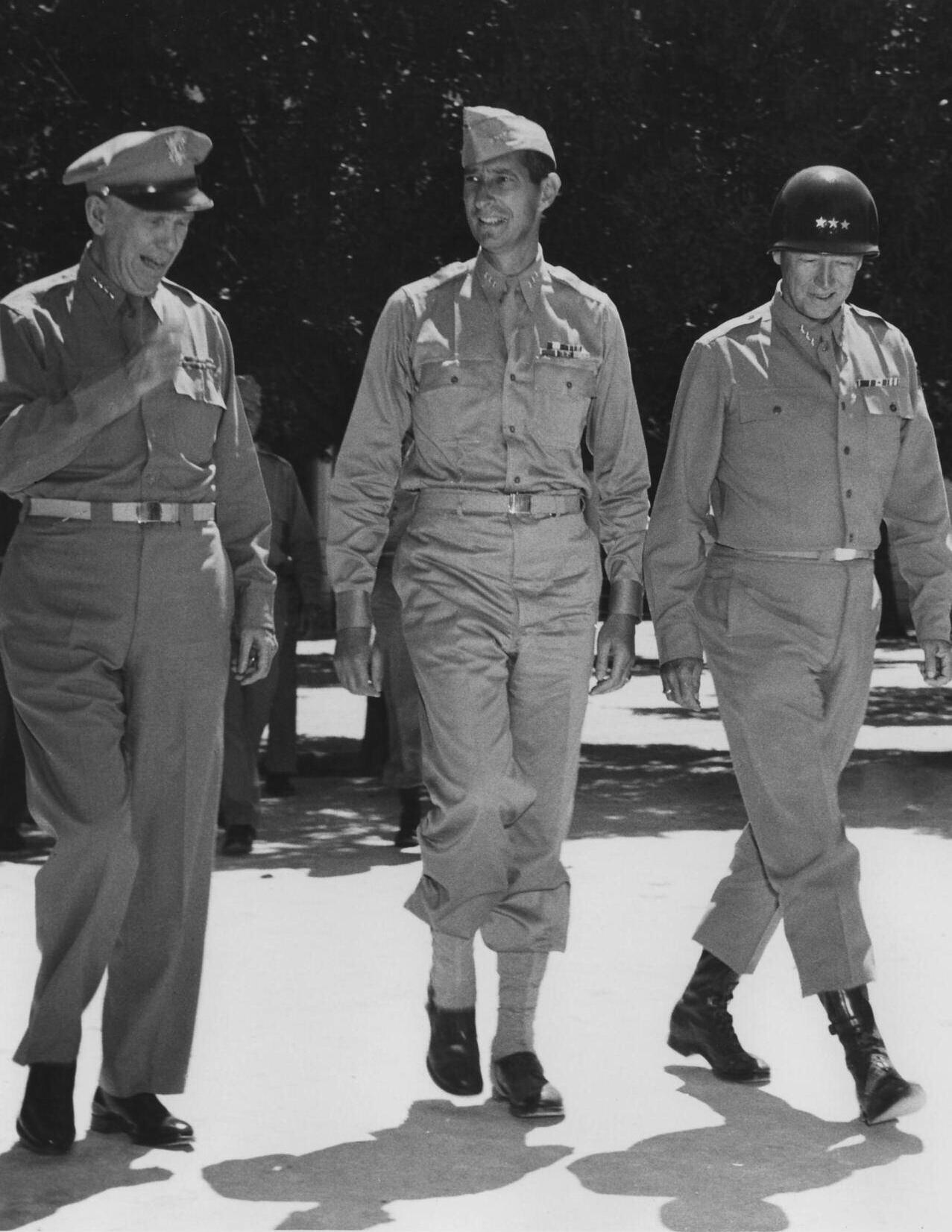
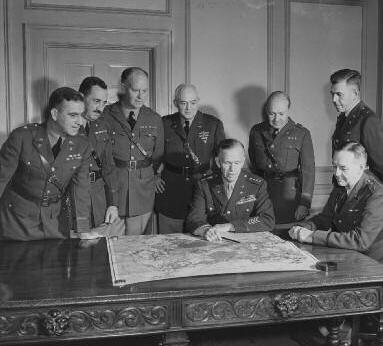

Marshall believed that it was impossible to separate an army officer’s character from his job performance. He t herefore made charac ter his pr imar y cr iter ion in his selection of combat commanders As he explained in a letter to a group of school children, “ e most important factor of all is character, which involves integrity, unselfish and devoted purpose, a sturdiness of bearing w hen e ver yt hing go es w rong and a l l are cr it ic a l, and a w i l ling ness to s acr ifice s elf in t he interest of t he common go o d ” C onvers ely, Marsha l l hate d “ c an’t,” grandstanding, indecisiveness, pessimism, a refusal to accept resp onsibi lit y, and delib erate dis cour tesy.
Army Chief of Staff General Marsha l (seated) with members of the War Depar tment General
13 M A R S H A L L F O U N D A T O N O R G F A L L 2 0 1 7
Staff nclud ng
Leonard
BG Raymond A Wheeler, BG Sherman
les, MG Henr y H
d, BG Wade H Ha slip, BG
y L Twaddle and MG Wi liam Br yden n Nov 1941 p h o t o c r e d i t : G e o r g e C M a r s h a l l R e s e a r c h L i b r a r y George Marshall & Wo r l d Wa r I I C o m b a t Commanders BY S T E P H E N R TA A F F E, P H D
p h o t o c r e d i G e o r g e C M a r s h a l R e s e a r c h L b r a r y is article is a summar y of the author s Marshall Legac y Series talk for e World Wars sequence delivered at the Marshall Foundation in July 2017.
(from eft to right): BG
T Gerow,
M
Arno
Harr
Allied
To Marshall, character was fate, a barometer for an officer’s likely performance at the head of his unit To b e sure, he o cc asiona l ly promote d and app ointe d p e ople w hos e charac ter he doubted, but he did so reluctantly and against his better judgment. Although there are plenty of instances throughout histor y of great generals who were also terrible human beings, it was a distinction Marshall rarely made in his army
… Marshall wholeheartedly agreed with the army ’ s prevailing ethos that an officer’s formal learning should not stop at his commissioning. It was instead a career-long process that kept minds nimble, up-to-date, and active.
Although Marshall prized character, he did not rely on it completely in his selection of highlevel combat commanders. He also valued education. e army had established a full-fledged education system at the beginning of the centur y, and Marshall wholeheartedly agreed with the army ’ s prevailing ethos that an officer’s formal learning should not stop at his commissioning. It was instead a career-long process that kept minds nimble, up-to-date, and active. As a result, he was reluctant to appoint an officer to corps, field army, or army group command unless he had attende d b ot h t he C ommand and G enera l St aff C ol lege in L e avenwor t h, Kans as, and t he Ar my War C ol lege in Washington e former school trained promising mid-level officers to ser ve as staff officers, and the latter taught the army ’ s brightest colonels to lead large units in wartime. Indeed, of the thirty-eight men who held corps, field army, and army group command dur ing World War Two, a l l but five attende d t he Ar my War C ol lege, and on ly one–ird C or ps commander James Van Fleet–never darkened the door of either school.
Marshall’s World War One experiences convinced him that younger officers–by which he meant men in their forties and fiies–should lead the army ’ s high level combat positions because they possessed the necessar y stamina, energ y, and vigor for such demanding posts When he became chief of staff, he was dismayed that so many elderly officers beyond their prime commanded such units. In response, he waged a protracted and tenacious campaign to supplant overaged officers with younger men and repeatedly complained that he was not getting the results he wanted Althoug h he tried to b e considerate of the feelings of thos e displaced, he made his reasoning perfectly clear. He explained to one relieved general:
We have had to be absolutely firm on the question of age for command. Not only that, but we must go much lower in the age groups for division and corps commanders t han we are now doing. Ever y bit of dat a we re ceive f rom t he fighting fronts clearly shows that this is a young man ’ s war except in rare instances and then only in the highest command I hope you will not be too much disappointed and that you will feel certain that there is nothing of reflection on you in this affair other than your birthday.
As a result, the average age at the war ’ s start of the men who ended up holding the army ’ s highest combat commands was the early fiies. As with character and education, Marshall was willing to bend his rules on occasion if, say, a theater commander insisted on the services of an older general. For example, under ordinar y circumstances, Sixth Army commander General Walter Krueger should have spent the war training troops stateside, but Marshall permitted him to go overseas
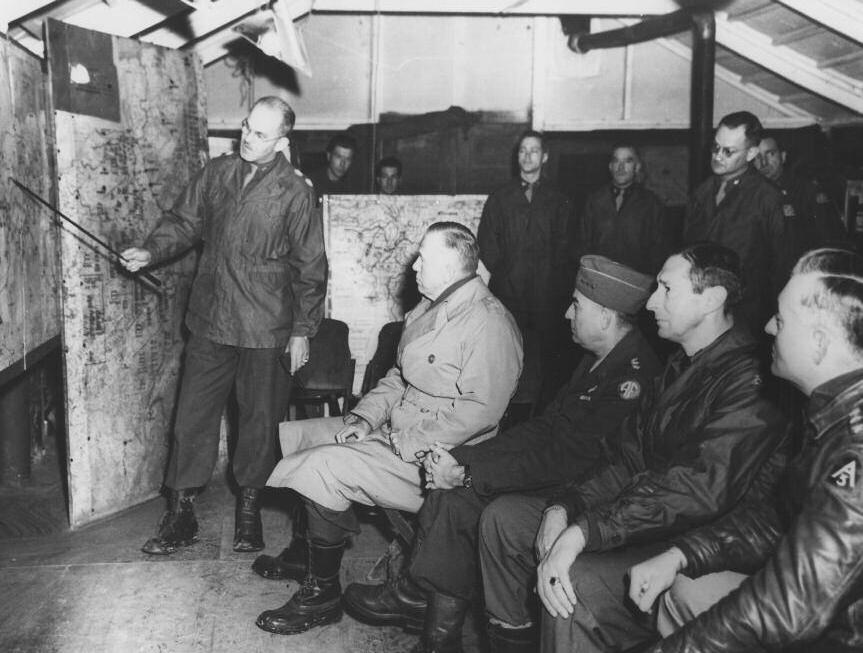

because General Douglas MacArthur, the head of the Southwest Pacific Area theater, specifically asked for him In most cases, though, Marshall believed that youthfulness trumped experience
Despite all his years in the small prewar army, it was impossible for Marshall to familiarize himself with ever y officer eligible for high-level combat posts. Consequently, he oen depended on the recommendations of those he trusted in selecting his combat commanders As the war progressed, he increasingly relied on the opinions of his theater commanders, especially General D wight Eisenhower. Marshall believed that theater commanders should have men of their own choosing working for them, so he was reluctant to force personnel on them As he explained to Eisenhower, “You do not need to take or keep any commander in whom you do not have full confidence. So long as he holds a command in your theater it is evidence to me of your satisfaction with him e lives of too many are at stake; I will not have you operating under any misunderstanding as to your authority, and your duty, to reject or remove any that fails to satisfy you completely” For instance, he had doubts about General Leonard Gerow’s ability to lead a corps for the invasion of Normandy but set them aside when Eisenhower vouched for him. Although the extent of these personnel negotiations varied according to the theater’s importance and Marshall’s relationship with its commander–Marshall’s interactions with Eisenhower, for instance, were far more open and freewheeling than with MacArthur–there was an unmistakable give-and-take to the process that reflected Marshall’s desire to give his subordinates as much leeway as possible in their personnel selections
He displayed little interest in an officer’s family background, service branch, political connections, or membership in any of the army ’ s innumerable cliques.
While character, education, and age were Marshall’s key criteria, he ignored several issues which had in the past sometimes played important roles in determining promotions and assignments in the army He displayed little interest in an officer’s family background, ser vice branch, political connections, or memb ership in any of the army ’ s innumerable cliques. For instance, he appointed General John Millikin a corps commander even though Millikin’s father-in-law was General Peyton March, the enemy of Marshall’s mentor, General John Pershing Nor did he
15 14 M A R S H A L L F O U N D A T O N O R G F A L L 2 0 1 7
p h o t o c e d i t G e o r g e C M a r s h a l R e s e a c h L b r a r y
Genera Marshal fo lows a briefing along with BG Joseph McNarney, LTG Mark C ark and BG Lucian Truscott, (a l seated) Fifteenth Army Group I taly Feb 1945
General Marshall stands w th LTG Jacob Devers (facing eft) MG David Barr (center) and LTG Mark Clark (right foreground) in I ta y, June 1944


c are much ab out et hnicit y or cre e d, t houg h t he ar my ’ s inst itut iona lize d racism and regimentation had largely homogenize d t he officer cor ps in those respects for him While Marshall pl ace d g re at emphasis on an officer’s character, he realized that good leaders c ame in different p ers ona lit ies and temperaments. He did not even mind eccentrics. Indeed, he had a so spot for some of the army ’ s talented unconvent iona l-t hin k ing o ddb a l ls such as General George Patton.
Most sur pr ising ly, Marsha l l did not consider a l ack of World War One battle experience a disqualifying factor for hig h-le vel comb at command
Some of the army ’ s greatest World War Two generals, such as Eisenhower and Omar Bradley, never heard a shot fired in anger before the conflict Once the United States entered the war, Marshall gave mental points to high-ranking officers who had a lre ady le d men against t he G er mans and Jap anes e, but he remaine d reluc t ant to penalize those who had done well in stateside tasks by denying them the chance to prove themselves in action. For instance, in the summer of 1944 he assigned the untested General Simon Buckner to lead the Tenth Army even though by then the army had plenty of combat-hardened commanders available for the job Marshall simply believed that Buckner had done well in his previous assignments and deser ved the opportunity to lead men in combat.
While Marshall placed great emphasis on an officer’s character, he realized that good leaders came in different personalities and temperaments.
Evaluating the record of the army ’ s World War Two cor ps, field army, and army group commanders is a thorny and subjective task e playing field for these men was by no means even and fair. For one thing, there were wide differences in the terrain upon which the officers campaigned and the enemy they faced e Germans were the more militarily sophisticated and technologically advanced opponent, but they also were willing to surrender when the situation warranted doing s o. On the other hand, the Japanes e emphasis on fighting to the death made even mopping-up duties inordinately dangerous While European War generals impressed the public and future historians by capturing thousands of German soldiers in the spring of 1945 as they rolled to and beyond the Rhine, a couple of months later Simon Buckner, the Tenth Army commander, sparked criticism because he had to practically destroy the Japanese garrison on Okinawa in an enormously costly effort to secure the island. In each case it was pretty clear that the enemy had lost the war, but the contrast between the German and Japanese response to this
reality clearly impacted the performances of the American generals involved Moreover, waging war under adverse topographical conditions also limited the chances of reputation-enhancing victor y. ose generals operating in New Guinea’s jungles, the Italian mountains, or Okinawa’s cramp ed spaces had much less ro om to maneuver and gain sp ectacular and e ye-catching triumphs than those clashing in the North African desert or central France In short, if Buckner had faced German soldiers in northwest Europe instead of Japanese soldiers on Okinawa, he might have achieved that same kind of successes that cemented Patton’s militar y reputation.
In addition, chronolog y mattered ose generals who took their units into combat earlier in the conflict, when the enemy was stronger and American troops greener, obviously had a more difficult time than those who deployed later in the war with combat-hardened divisions against a weakened opponent It is therefore not entirely fair to compare, say, Van Fleet’s dash across G er many in t he spr ing of 1945 wit h G enera l L loyd Fre denda l l’s unsuccessf u l op erat ions in North Africa two years earlier. Van Fleet was facing a demoralized enemy at the end of his rope, whereas the Wehrmacht Fredendall encountered was still a potent force
Fina l ly, a genera l’s commander help e d deter mine his achie vements. It did not matter how accomplished a field army or cor ps chief was if his sup erior failed to us e him prop erly and provide him with chances to excel Some generals’ pedestrian tactics gave their lieutenants little opp or tunity to shine. More flexible and daring generals, on the other hand, p ermitted their field ar my and cor ps commanders f re e rein to conduc t t heir b att les cre at ively. Patton, for example, accrued big militar y dividends by giving his corps commanders considerable leeway in northwest Europe On the other hand, General Courtney Hodges, the First Army chief, stifled

17 16 M A R S H A L L F O U N D A T O N O R G F A L L 2 0 1 7
p h o t o c r e d t G e o g e C M a r s h a R e s e a r c h L b r a y
Genera Marshal and MG Wade Ha sl p, CG, XV Corps Oct 1944 in France
p h t d i t G g C M h l R h L b y
Omar Bradley
General Marshall (third from left) s shown with (left to right)
MG Joseph McNarney, LTG Mark Clark
BG Edward Almond, BG Lucian Truscott, LTG Wil iam Livesay and MG W ll s Crittenberger on a vis t to the Fifteenth Army Group, 92nd D v sion, Feb 1945 in I taly

the initiative of most of his corps commanders with his conventional and unforgiving attitude. As a resu lt, t he re cord of Patton’s lieutenants outshone t hos e of most of Ho dges’. es e limitations do not excuse a general’s poor record–aer all, a sign of greatness in any endeavor is overcoming counterproductive circumstances–but they do help to explain them.
… they were proud not only of their own battlefield accomplishments but also of those of their colleagues.
Despite these caveats, there is evidence to support the argument that Marshall appointed quality generals to lead high-level combat units during the war For one thing, there was considerable stability among this cadre throughout the conflict. Of the thirty-eight generals who held corps, field ar my, and ar my g roup command in comb at, s e vente en le d t heir units f rom t ime of deploy ment to t he end of t he war Four te en of t hem, or ne arly t hir t y-s e ven p ercent, were remove d f rom t heir j obs. Of t hes e four te en officers, t houg h, six were promote d to more important positions. ree others were relieved due to illness and one, Buckner, was killed in action is le five generals who were dismissed for perceived battlefield failures: Fredendall in Nor t h Af r ica, G eneral Er nest D aw le y at Saler no, G eneral John Lucas at Anzio, General Charles Corlett along the FrancoGerman border, and Millikin at Remagen Even among those five, it is possible to argue that personalities and politics played as much a role in the removals from command for four of them as a l lege d incomp etenc y. Inde e d, Fre dend a l l’s relief is t he on ly one t hat fai le d to generate controversy from both historians and contemporaries Such low turnover is in this instance an indication of quality generalship.
In addition, the testimony of these high-level commanders provides evidence of the quality of Marshall’s selections ere is surprisingly little scapegoating in the contemporar y reports and postwar memoirs of these men. With a few exceptions, they were proud not only of their own battlefield accomplishments but als o of thos e of their colleagues. At the end of the war, for example, Eisenhower polled his four field army commanders about the officers who led their

corps All four of them, including the irascible Patton, claimed that the y had the b est cor ps commanders in Europe Although it is easy to b e generous in victor y when there is plenty of credit to distribute, the reluctance of thes e men to blame each other for failures sp eaks well of Marshall’s generals.
Finally, and most obviously, t he fac t t hat t he ar my defe ate d its G er man, It a li an, and Jap anes e opp onents demonst rates t he w is dom of Marshall’s appointments
S ome argue that Allied victor y was a l l but ine v it able because American materiel sup er ior it y in p ar t ic u l ar enabled the S oviets, British, and Americans to over whelm their enemies By this logic, the American army did not need good generals, so Marshall’s selections would have sufficed regardless of their quality. ere was in fact nothing inevitable about Allied victor y. Winning the war required far more than materiel strength ere are aer all plenty of instances of smaller and poorer nations triumphing over bigger and wealthier ones. Allied success was due to a variety of factors, including astute diplomacy, effective coordination, economic management, clever propaganda–and skilled generalship To be sure, the American army did not require brilliant generals able to overcome tremendous odds Instead, it needed competent ones capable of applying the army ’ s doctrines to the war. Happily for the United States, Marshall was able to find such men and place them in responsible positions. As a result, the army won its war at an acceptable cost and in a tolerable amount of time Once it brought its power to bear, it never lost a major engagement From this perspective, the astuteness of Marshall’s selections is almost self-evident.
Steve Taaffe teaches histor y at Stephen F Austin State University in Texas. He has written several books, including three about aspec ts of World War II. One of those books is Marshall and His Genera s U S Army Commanders in World War II that was published in 2011 This ar ticle is based
Review ng the 7th Infantr y D v sion that par ticipated in the invas on of the Marshal Islands are (left to r ght)
MG Charles E Corlett (CG, 7th Infantr y D v sion), Genera Marshal and LTG Rober t C R chardson, Jr (CG Army Forces, Centra Pacific), 1944
on his presentation in July as par t of the Marshall Legac y S er ies sequence on The Wor ld Wars. You can see the recording of his talk by going to our YouTube channel accessible through our website


19 F A L L 2 0 1 7 18 M A R S H A L L F O U N D A T O N O R G
p h o t o c r e d i t G e o g e C M a r s h a l R e s e a c h L b r a r y p h o t o c r e d i G e o r g e C M a r s h a l R e s e a r c h L b r a r y
With the United States fighting a global war, it would fall to his loyal U.S. Army Chief of Staff, General George C. Marshall, to be the lynchpin of the U.S. Joint Chiefs of Staff in achieving final victory over Nazi Germany and Japan.
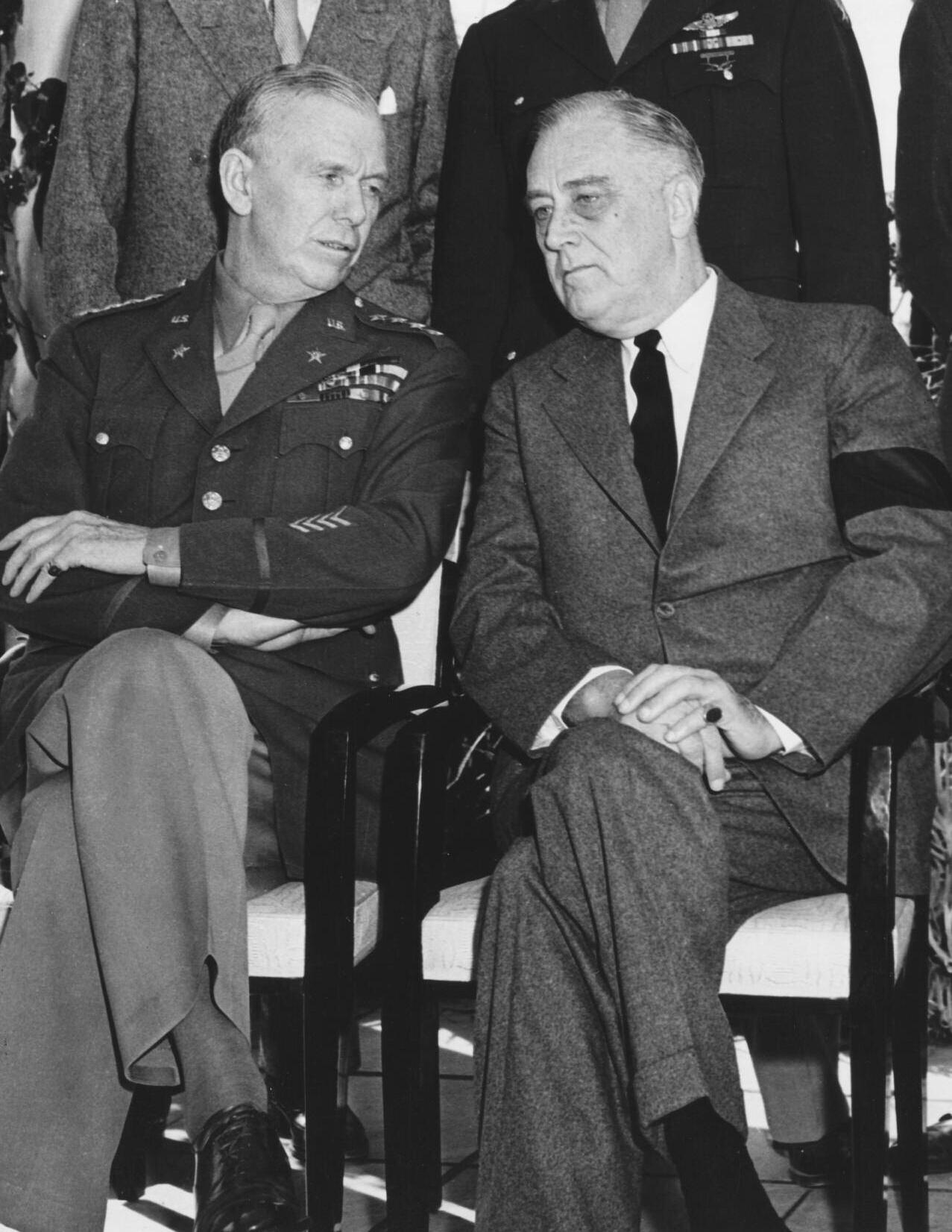
D-Day–Operation O verlord as it was codenamed–was planned to be the largest amphibious invasion in human histor y. e selection of its supreme commander, late in 1943, was therefore of huge and historic importance, as ever yone in militar y circles was aware. Who should it b e? Even St a lin, w hos e forces wou ld mount an e quiva lent offensive from the East, became fretful at the “Big ree” Tehran conference in November, predicting Overlord would fail unless the right commander was immediately appointed, in sufficient time to ensure victor y.


Stalin was right–though not for the reasons he imagined For Franklin Roosevelt, as C ommander in Chief of the armed forces of the United States, the problem was not who to appoint, but how to stop the British from sabotaging the invasion. And to do this, paradoxically, he had needed to hold back on the app ointment of its commander to the ver y last moment
roughout 1943, as I’ve related in Commander in Chief: F DR’s B at tle w ith C hurchill , 1 9 4 3 , the British prime minister and his militar y chiefs of staff had fought the President and U.S.
The British team did not believe in Overlord, preferring the idea of postponement for yet another year or more...
Joint Chiefs of Staff, their supp os ed coalition par tners, rather than the enemy It was a sorr y saga In May, 1943, they’d come to America in their hundreds on a transatlantic liner, the Queen Mar y, to do battle against Overlord. ough they failed, they were back in North America to tr y it yet again, three months later, in August 1943, aboard the same ocean liner, bringing more than two hundred assistants and clerks
21 M A R S H A L L F O U N D A T O N O R G F A L L 2 0 1 7
p h o t o c r e d i t G e o r g e C M a r s h a l R e s e a r c h L i b r a r y Genera
in Nov 1943 Marshall
P r e s i d e n t , 1943 BY N I G E L H A M I LTO N, P H.D p h o t o c r e d t G e o r g e C M a r s h a l R e s e a r c h L b a r y is
Marshal and Sir John Dil at the Tehran Conference
and the
article is a summar y of the author s Marshall Legac y Series talk for e World Wars sequence delivered at the Marshall Foundation in May 2017.
Generals Marshall (left foreground) Arnold (next to Marshall) and others at the Quebec Conference in August 1943

e British team did not believe in Overlord, preferring the idea of postponement for yet another year or more, while meantime exploiting Allied operations in the Mediterranean–striking east into the Aegean, forcing Turkey into the war, and advancing north through the Balkans, possibly even invading Germany from Austria and the Danube.
Churchill, for his part, simply paid lipservice to the formal Quebec agreement, which made Overlord the Allies’ absolute priority, with a launch date of May 1, 1944.
e President and his American team had said no. e terrain was awful, the Germans were defending ever y yard, and the strategy–especially the idea of forcing the Dardanelles and entering the Black Sea–was woolly and more reminiscent of Churchill’s disastrous campaign at Gallipoli, in 1915, than the current war. By threatening to exclude Britain from further research to develop an atom bomb, the President had managed to quell Churchill’s insurrection in August 1943, however. And to make sure the Allies stuck to the crossChannel invasion and its timetable, he had insisted it should b e commanded by an American, not a Briton Churchill was thus forced to back down and to tell General Sir Alan Brooke, his British Army Chief of Staff, he would not lead the invasion. General George Marshall would.
Brooke was hurt by the decision, he later admitted, but certainly not devastated; he did not think Overlord could possibly succeed. Aer all, it was quite a challenge; not even Hitler had dared attempt a cross-Channel invasion in the summer of 1940, when France was prostrate and defeated
Churchill, for his part, simply paid lip-ser vice to the formal Quebec agreement, which made O verlord the Allies’ absolute priority, with a launch date of May 1, 1944. Instead of sticking to a fall-and-winter strateg y of limited operations on the mainland of Italy, while preparing for the cross-Channel assault, he therefore launched British invasions of Rhodes, C os, Leros and Samos in the Aegean, without the approval of General Eisenhower, the Allied C ommander in Chief in the Mediterranean, or even knowledge in Washington of the attacks. e Wehrmacht had no difficulty in crushing the British forces, killing, capturing or forcing their evacuation from each island, to a man.
Instead of swallowing defeat, however, Churchill went “mad,” in t he opinion of G enera l Bro oke, his main mi lit ar y adv is er. In O c tob er 1943 he t hus de cl are d a third war against the President and U.S. Chiefs of Staff: demanding t hat D-D ay b e p ostp one d a f ur t her ye ar w hi le t he A l lies t r ie d yet more op erat ions in t he Mediterranean and Aegean.
It was in t his d ark context t hat t he President was compelled to mount a counteroffensive against its own ally, using General George Marshall as his weapon, or chess pie ce, dep ending on how one v ie ws t he “ cr isis” that enveloped the Allies in the fall of 1943.
Crisis–a word Churchill used, since he was its progenitor–was no misnomer By late October, 1943, Churchill was openly threatening in fact to resign as prime minister unless the President’s strateg y, agreed at Quebec, was overturned, and Allied priority was switched to the Mediterranean, Aegean and Balkans. President Roosevelt duly attempted to hold Churchill’s feet to the fire by simply ignoring his predictions of disaster and defeat, and insisting instead that they stick to the Quebec accords
It was to no avail, however. Churchill was Churchill–indomitable in defeat, and relentless in his obsessions, with a master y of rhetoric that wore down e ven the most skeptical of his British advisers and sub ordinates. e Prime Minister thus p ersuaded his Chiefs of Staff to agree to his demands for an Anglo-American militar y conference, or showdown in November, 1943, to decide the issue before they all met with Stalin in Tehran at the end of the month
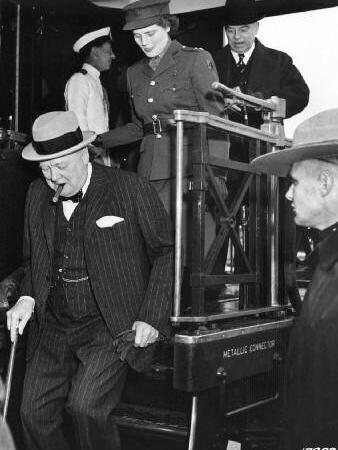

Embarking on the latest U.S. battleship, the USS Iowa, on November 13, 1943, the President therefore worked out with his Joint Chiefs of Staff a new plan to deal with the British insurrection. ey would refuse to discuss any change in the Quebec agreement in Cairo, en route to Tehran Instead they would use General Marshall as a chess queen to attack Churchill’s king, demanding that Marshall not only assume command of O verlord, but of the Mediterranean and Middle E ast, to o at way Marshall would b e able to put the kaib osh on any attempts to delay or de-prioritize D-Day. And if that counteroffensive failed–as the President felt it probably would–then it would still leave no time in Cairo to discuss Churchill’s alternative strateg y before flying to Tehran on November 27 ere, in the legendar y capital of the kings of Persia, Stalin would, the President had gotten confirmation from his ambassador in Moscow, help him to put down the British revolt: two against one.
Br tish Prime Minister W nston Churchi l and Canadian Prime M nister W.L Mackenz e King d sembark a tra n at Wolfe’s Cove and head for the Quebec Conference in August 1943.
C ockwise from top left: Canadian Pr me Min ster K ng British Pr me Minister Churchi l U S Presdent Franklin D Rooseve t and Canada s GovernorGeneral the Ear of Athlone, at the Quebec Conference in August 1943
22
23 M A R S H A L L F O U N D A T O N O R G F A L L 2 0 1 7
p h o t o c e d i t G e o r g e C M a r s h a l R e s e a c h L b r a r y p h o o c r e d t G e o g e C M a r s h a l R e s e a r c h L i b r a r y p h o t o c r e d t G e o r g e C M a r s h a l R e s e a r c h L i b r a r y
And so it transpired Churchill refused to accept Marshall as an “all Europe” Supreme C ommander e British and American teams therefore went to Tehran at loggerheads In the Russian embassy, where the summit took place, Stalin assisted the President in squashing Churchill’s wild dreams with a display of cold militar y realism that impressed even General Sir Alan Brooke. e Soviets would launch an equivalent grand offensive from the East, simultaneous with the launch of Overlord on May 1, 1944, from the West; the Wehrmacht would be crushed between, and the war against Hitler won. Aer that the Soviets would join forces with the U.S. to defeat Japan.
e President was delighted Overlord would, even Hitler conceded, be the “deciding battle” of the war. Which le only the question, who would command it?
In Tehran it was assumed General Marshall would be appointed–indeed Stalin was so impressed by Marshall’s bearing and militar y intellect he could not understand why the President still held off making the appointment official.
e President assured him he would do so, however, in two or three days, as soon as he got back to Cairo on December 2 And he did–though not in the way Stalin–or Marshall, or anyone elsehad supposed.
General Marshall had been made U S Army Chief of Staff by the President during his second term, in 1939 He had won the President’s respect for his coolness in all situations, his militar y bearing, his absence of ego, his devotion to duty, and his high-level administrative ability–setting goals and delegating necessar y authority to competent subordinates. He had earned the respect, too, of Congress in the many hearings he had been required to attend, for budgetar y and other reasons. But as a combat commander/supreme commander?
Here the President was not so sure
He had won the President’s respect for his coolness in all situations, his military bearing, his absence of ego, his devotion to duty, and his high-level administrative ability
Too much perhaps the delegator, Marshall was not infallible as a militar y strategist, or in his assessment of combat capabilities–American, German or Japanese. He’d failed to predict or prepare for a possible Japanese attack on Pearl Harbor, had pressed for a cross-Channel assault in 1942 before a single shot had been fired by an American at the Wehrmacht, had protested the President’s American-led “ Torch” invasion of North Africa risked failure, had held back Eisenhower’s forces in Morocco in fear of an unlikely German flank assault across the Mediterranean, and had argued for a cross-Channel invasion again in 1943, before U.S. commanders and forces had proven they could worst the Wehrmacht in battle–and therefore finding himself embarrassed by Allied defeat at Kasserine He had not, in short, demonstrated to the President he could be the kind of effective supreme commander necessar y for a coalition operation as critical as Overlord
Even more influential in the President’s mind was the fact that General Pershing, the aging but venerated commander of U.S. troops in Europe in World War I, felt strongly it would be wrong to move Marshall from Washington, as he’d written to the President in no uncertain terms back in S eptember–arguing that O verlord was only a part of the global chessboard, and therefore
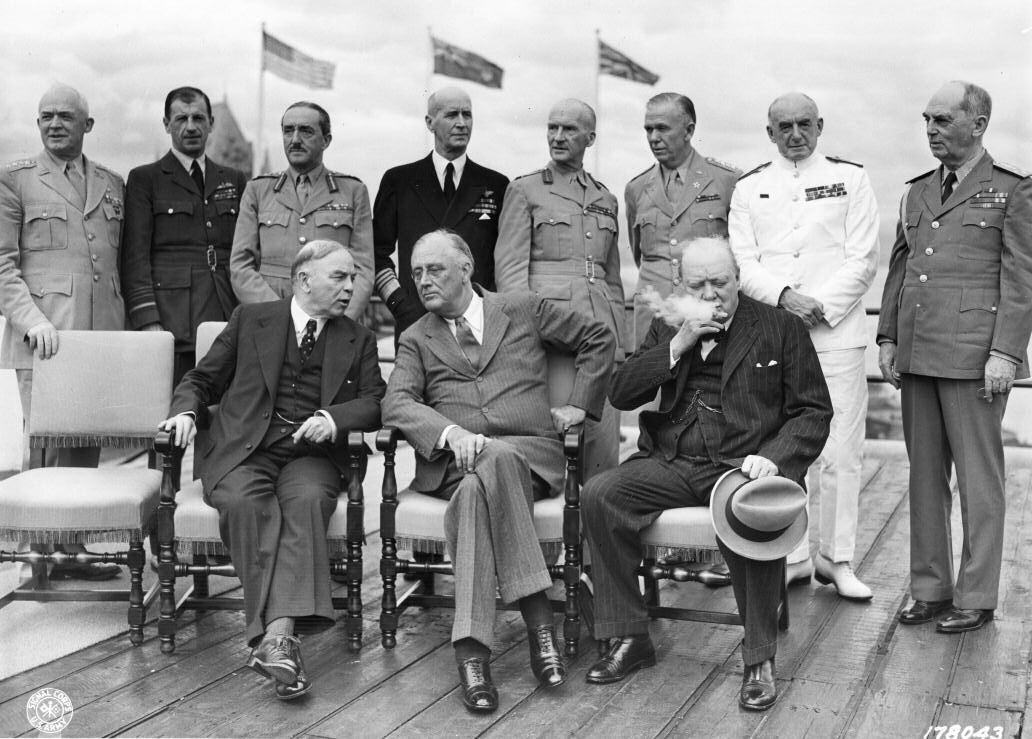
beneath Marshall’s talents. Mr. Roosevelt had responded that he was thinking of an “all Europe” command, not just northern Europe; in which case Marshall should surely be given the opportunity to make histor y.
Now that Stalin had helped put down the British revolt, however, Overlord was the Allied priority Its timetable was set in stone With no chance Churchill would agree to an American taking command of “all Europe,” north and south, Overlord would be the major color in the tapestr y of the war–but only one color. Pershing’s advice now seemed eminently sensible. Which le only the President’s quasi-promise to Marshall, if the general wanted the historic Overlord command Did he want it?
e President had never actually told Marshall directly he was to command the Overlord invasion Even the minutes of the U S high-command meetings convened by the President aboard the Iowa on its way out to the Mediterranean had recorded an assumption by the President rather than a decision–and one based on the idea, aer all, of an “all Europe” command.
General Marshall had told his wife to begin moving their furniture into storage, pending his move, and had even alerted some of his chosen staff he would probably be needing them abroad, all too soon. But on arrival in Oran, he’d asked for tropical clothes, not London wear ; and to Eisenhower he’d complained he felt they were like pieces on a chess board, which the President was playing with. In other words, it was not a done deal, by any means. us, when Harr y Hopkins, the President’s White House counselor, arrived at Marshall’s villa in Cairo the next evening, one day aer their return from Tehran, asking what were his feelings about the Overlord command, Marshall realized what this meant. e President was having second thoughts.
Were they second, rather than first, all along?
Canadian Pr me
M nister W.L Mackenz e King, U.S. President Frank l n D Roosevelt and British Pr me M nister W nston Churchi l (a l seated) w th Henr y H. Arno d, Sir Charles Por tal
Sir Alan Brooke, Ernest J K ng Sir John Di l George C Marshal , S r Dudley Pound Wi liam D Leahy (al stand ng lef t to right) at the Quebec Conference in August 1943
24 M A R S H A L L F O U N D A T O N O R G
25 F A L L 2 0 1 7
p h t d t G g C M h l R h L b y
President Roosevelt was wont to explain his sphinx-like decision-making process by saying he had two hands, and that the le one oen did not know what the right one did; in other words, he liked to hold at least two options open in making any decision. He was probably the most instinctive strategist ever to occupy the Oval Office, exerting his leadership by a kind of magic in which each supplicant thought he had the President’s actual or implied support It led to a thousand crossed wires and frustrations–but he towered so high above any other politician or leader in the nation that few, beyond certain right-wing, isolationist newspaper moguls, dared openly cross him He swept people along, as if on a half-idealistic, half-realistic journey that was forever positive and for ward looking. He was in short hard to know, but easy to like and love–at least from a distance.
It is thus beyond doubt–mine at least–that General Marshall knew what Hopkins’ visit meant He had most recently thought himself favorite for the post because Stalin, commander in chief of the Soviet armies, had so obviously taken a liking to him, and had pressed the President again and again to make the crucial decision But that was not what Hopkins’ enquir y, or his manner, suggested. R ather, they implied the President was seeking, as he so oen did, a way out.
Would telling Hopkins that he, George Marshall, had being counting on getting the historic command, that he wanted it and felt he was the right man to take it, have helped change or sway the President’s mind?
The President had used him as a chess queen to, keep Churchill on the defensive–and had gotten what he wanted: D-Day.
It is doubtful. Marshall was Marshall, and could not become a Patton-like, or even MacArthur-like egotistical commander overnight. e President had used him as a chess queen to, keep Churchill on the defensive–and had gotten what he wanted: D-Day He didn’t actually need Marshall in that battlefield command capacity. Tr ying to convince the President he should go against his instinct–an instinct that had ser ved Mr. Roosevelt so extraordinarily well since Pearl Harbor–would only make the inevitable decision more difficult, and the future path more stony
Whether Marshall slept that night we do not know. As Dr. Forrest Pogue, his authorized biographer, put it, the general’s prose in his personal correspondence tended to be “laconic,” which made it the “despair of the biographer ” e next day, however, aer a Joint Chiefs of Staff meeting, the President invited Marshall to lunch with him at his villa overlooking the Pyramids and the Sphinx, alone. Aer a certain amount of “beating about the bush,” the President told him he was going to give the O verlord command to young General Eisenhower, with whom he’d spent two days on his way to Cairo and another in Cairo itself before the presidential party had flown to Tehran.
It was Saturday, December 4, 1943, and the other Chiefs were duly informed aer lunch e British Chiefs and their prime minister were told that evening
How did Marshall react? He must have been upset, as any soldier would be, to be passed over. e President, in his charming way, had sugared the pill by saying it was best so, since he would not be able to sleep in Washington without him there But in later years Marshall could not
remember correctly even the day he’d been told, or whether it was before lunch or aer, or during the meal All historians since then have thus mistaken the date, following Marshall’s mistake–ascribing this, the most consequential command appointment of World War II, to the wrong day, December 5, when it was really December 4.
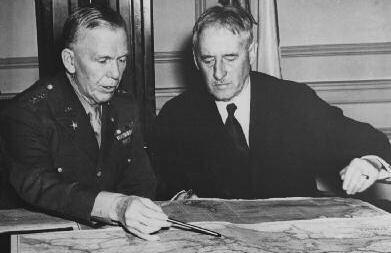
No wider announcement was made, for the moment–even to Eisenhower. Perhaps to avoid having to meet with the man who had taken the role he’d coveted, for the moment, Marshall decided to go the other way : to the Pacific, without even telling the President. As soon as the President sent his cable to Stalin to announce formally his decision, on the night of December 6, as he prepared to leave Cairo for the journey home, Marshall set off to the east ere, in the Pacific, he would meet the U.S. commanders in the field, such as MacArthur, fighting in the larger, global war. He would also have time to collect his thoughts–his “grief,” as Dr Pogue put it–and return several weeks later to Washington the strait-laced, no-nonsense general ever yone knew and admired.
Marshal Stalin, aer mulling it over, thought it a good choice. e Secretar y of War, however, did not take the news nearly so well It was, Henr y Stimson confided in his diar y, a “revolutionar y change,” and Stimson’s first impression was that it was “ a great mistake” by the President.
As histor y would show, it wasn’t–not simply because young General Eisenhower proved a genius at welding together, in five short months, the forces of a rainbow coalition of nations and putting them into successful battle against the vaunted legions of the Wehrmacht, but b ecaus e of something equally significant–in fact even more significant than General Pershing could have predicted For, although the President returned from Tehran bronzed and in robust good health, as e ver yone who saw him averred, he fell sick with flu a fe w days aer Christmas–and the sickness never got better. By March, 1944, racked with bronchitis, he was examined by specialists–and was told he was dying His heart like his father’s–was suffering fatal cardiac disease
As President and Commander in Chief, Mr. Roosevelt would still have some important decisions to make, but to all intents and purposes he was, like President Wilson in 1920, an invalid. With the United States fighting a global war, it would fall to his loyal U S Army Chief of Staff, General George C Marshall, to be the lynchpin of the U S Joint Chiefs of Staff in achieving final victor y over Nazi G ermany and Japan. Keeping him in Washington was one of the finest decisions Franklin Delano Roosevelt ever made.
Dr. Nigel Hamilton has been studying Frank in Roosevelt as U S commander in chief in W WII for many years An award-winning Anglo-American historian and biographer he is completing the third volume of his FDR at War trilogy. This ar ticle contains the substance of his presentation in May 2017 as par t of the Marshall Legac y Series sequence on The Wor d Wars
Dr Hamilton is best k nown for Mont y, his three volume study of W WII field commander Fiel M arshal B er nard M ontgomer y Dr Hamilton many books have been trans ated into 17 lan guages He divides his time bet ween B oston where he is senior fellow in the M cCor mac Graduate S chool Universit y of M assachu setts–Boston, and New Orleans Louisiana

27 F A L L 2 0 1 7 26 M A R S H A L L F O U N D A T O N O R G
p h o t o c e d i : G e o r g e C M a r s h a l R e s e a r c h L b r a r y
Genera George C Marshal and Secretar y of War Henr y St mson confer n the War Dept n Januar y 1942

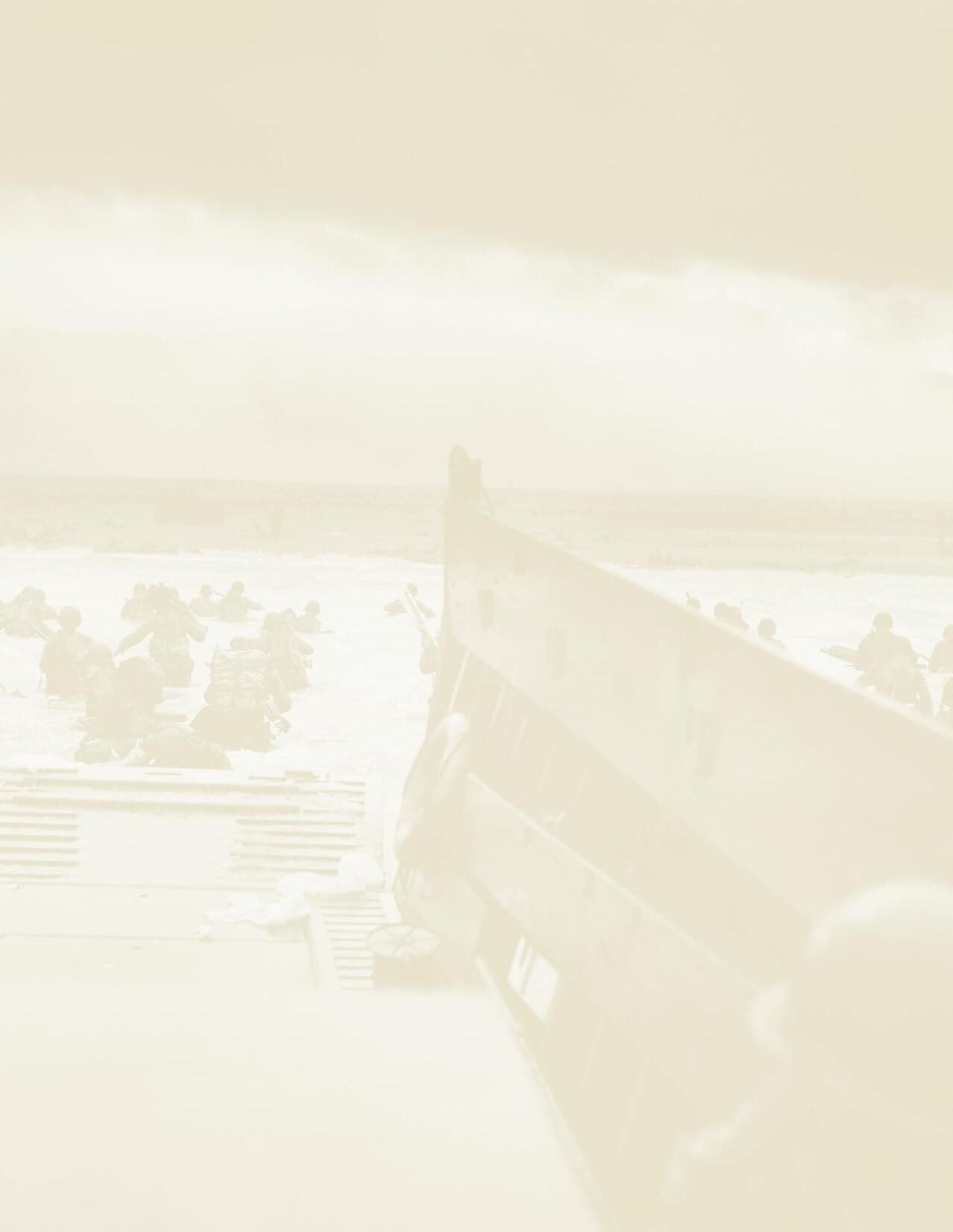
Myths, Marshall and World War II

Myths dominated two sessions of The World Wars sequence this spring.
In March, Paul Barron, former director of the Marshall Librar y, discussed Marshall myths, including the Little Black B ook that General Marshall kept. It did not contain the names of up-and-coming Army officers as many have surmised Yes, there is a black book, but the names of those future Army leaders were kept instead in Marshall’s memory. Marshall was introduced to many of them during his assignment as assistant commandant at Fort Benning when he revamped the Infantr y S chool curriculum and met this collective of future generals called “Marshall’s Men,” several of whom are shown on the following pages.
One month later three distinguished scholars discussed “Myths of World War II ” Dr Mark A. Stoler, professor emeritus of histor y at the University of Vermont and editor of volumes 6 and 7 of The Papers of George Catlett Marshall, began the evening by presenting myths
about prewar appeasement, U S isolationism, Pearl Harb or and U.S. entr y into the war, among others. Dr. Michael C. C. Adams, Regents Professor of Histor y Emeritus at Northern Kentucky University and author of T he B est War Eve r , analyzed the triumph of the Good War myth in the last years of the 20th centur y. Finally, Dr. Conrad C. Crane, chief of historical ser vices for the Army Heritage and Education Center at Carlisle Barracks, talked about numerous myths of the air war, the dangers of monocausal explanations about the defeat of Japan, and the misus e of historical analogies.
Dr. Stoler’s pres entation s et the tone. “Most myths, not all of them, have a basis in fact It is the distortion of that fact that leads to the myth,” he said. He recited a summar y of myths of World War II as they were seen late in 1945 e United States had b een wrong to reject Woodrow Wilson’s vision and membership in the League of Nations and had retreated into isolationism and militar y unpreparedness, he began. e result had been the rise of powermad dictators who seized power in Germany, Italy and Japan and formed the Axis alliance to conquer the world. e demo cracies of Britain and France had foolishly attempted to app eas e thes e dictators which had only increas ed their p ower and app etite and led to the outbreak of World War II. By mid-1940 the Axis sto o d on the verge of total victor y Only then did the United States realize its past errors, begin to re-arm, and decide to provide first Britain, then China and Russia, with
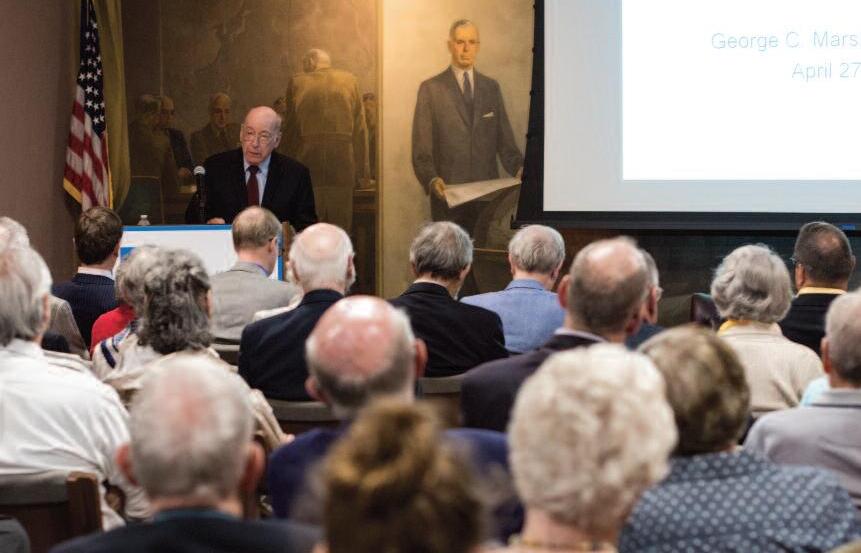


militar y aid free of charge at led the Axis to attack the U.S. at Pearl Harbor with Japan acting on B erlin’s order. “Our response was to create and use around the globe the largest and most powerful army, navy and air force in U.S. histor y and indeed in world histor y and to defeat the Axis virtually by ourselves by 1945,” he said in concluding the myths narrative.
Countering these perceptions, he said, “It is an ethno centric and grossly distor ted vie w of how and why World War II occurred, how and why we b ecame involved, and how the Axis were beaten It also ignores the roles and perceptions of other powers and peoples, of the war, the hop e for a p ost-war world and this countr y, ” he said e realities, among others, include the following. “ e Axis alliance was not a conspirac y r un by B erlin. In fact it wasn’t e ven an alliance ere was no trust between the partners, no cooperation during the war, and this is a key reason for the fact that they lost the war, ” Stoler said
e United States was not is olationist at all during the inter war years or as militarily unprepared as the myth holds, he contended “ e countr y was deeply involved in international affairs during the 1920s despite the fact that it did not join the L eague, primarily through its enormous economic p ower…It used the years 1939 through 1941 largely with Marshall’s prodding to prepare for war It was not prepared on Dec. 7, 1941, but it was more prepared for war than it had been for any previous war War Plans were completed You had one of the largest navies in the world. And Marshall had raised the army from 175,000 to 1 5 million men, ” he explained
He continued, “Germany did not mastermind the Pearl Harbor attack, and it was not the result of U.S. aid to Britain and China….e United States was not totally responsible for Allied victor y in World War II….B elief that it was ignores the massive contributions and perspectives of our numerous allies, most notably the British and the Russians.”
You can read more about both Myths presentations in the fall issue of The Strategist, and you can s ee the entire pres entations on the Foundation’s YouTube channel that is accessible from the website Dr Stoler will return to L exington on Octob er 18 to pres ent a summar y lecture on Marshall’s legac y f rom the world wars

Dr Mark Sto er ( eft) ta ked about Wor d War I myths as did Dr Michael Adams (be ow, far left) and Dr Conrad Crane (be ow, left)
L e g a c y S e r i e s S C H E D U L E e World Wars
Jan Dec 2017
October 18
Dr Mark Stoler discusses “George C Marshall Sold er of Peace ”
October 29
Victory Chef Cook-off: Cu s ne de Casablanca
November 18
Pa nt Party Marsha l and the Monuments Men Europe’s Unlikely Recovery
Jan Apr 2018
January 25
Dr Barry Machado opens the next sequence Europe s Unlike y Recovery introducing the Marsha l Plan “New Light on the Origins of the Marsha l Plan ”
January 25
The new exhib t on, “Hope for Those Who Need t ” opens in the Lower Gal ery
To see the ineup for the rest of the Marsha l Legacy Series, go to our website
28 M A R S H A L L F O U N D A T O N O R G
29 F A L L 2 0 1 7
Paul Barron d scussed Marsha l Myths n March
Por trait of the tactical nstructors at For t Benn ng in 1929 George C. Marshall is seated front and center Th s photo ncludes future genera s Joseph St lwe l seated to Marsha l s r ght, and Omar Brad ey who s standing beh nd Marshall s right shou der.

e term Marshall’s men has b een toss ed about, yet few people know it originated from Marshall’s assignment at Ft B enning (192732) during which he modernized the Infantr y School curriculum in anticipation of the fighting in the next big war “Simplicity, innovativeness, and mobility would be the hallmarks of the U.S. Army of 1941-45, and the leadership of that army would consist over whelmingly of ‘Marshall’s Men’ from Fort B enning. In all, 200 future generals passed through the school during his years there, 150 as students
and 50 as instr uctors. e latter categor y, which included names such as Joseph Stilwell and Omar Bradley, Marshall labelled ‘the most brilliant, interesting and thoroughly competent collection of men I have ever been associated with,’” wrote Larr y Bland, editor of the Marshall Pap ers in the first volume.1 Hundreds more who would lead the field learned from Marshall at B enning.
So who were these Marshall’s Men? Some photographs bring the group to life.
1 From T he Pape rs of G eorg e C atlet t Marshall , L arr y B and, editor Vol. 1 “ The S oldierly Spirit,” December 1880 – June 1939



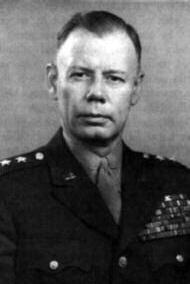





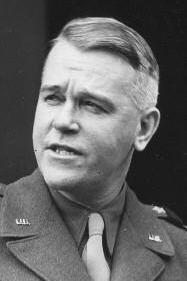

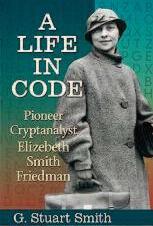
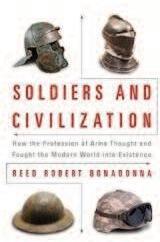

B E S T N E W B O O K S
e Woman Who Smashed Codes: A True Stor y of Love, Spies, and the Unlikely Heroine Who Outw itted America's Enemies (Harper C ollins) by Jason Fagone
Soldiers and Civ iliz ation: How the Profession of Arms
and Fought the Modern World into E xistence (Naval Institute Press, 2017) by Reed B onadonna
A Life in Code: Pioneer Cr y ptanalyst Eliz ebeth Smith Friedman (McFarland) by G. Stuart Smith
30 31 M A R S H A L L F O U N D A T O N O R G S H O R T S F A L L 2 0 1 7 M A R S H A L L’S M E N R O OT E D I N F O R T B E N N I N G E X P E R I E N C E
ought
p h o t o c r e d i t G e o g e C M a r s h a l R e s e a c h L b r a r y
C ockwise from upper left: Omar Bradley, Joseph St lwell James A Van Fleet, Walter Bede l Sm th, John E Dahlquist, Terr y Al en Lawton Co lins, Matthew R dgway Manton S Eddy and Leonard Gerow
p h d t G g C M h l R h L b y
Gen Marshal rides w th Edward Almond (center)
the last word
“ I h o p e , s o m e d a y , e v e r y o n e i n A m e r i c a w i l l
r e a l i z e w h a t a d e b t h e o w e s t o G e o r g e M a r s h a l l .
T h e r e ' s j u s t n o b o d y l i k e h i m . N o b o d y ! ”
President Frank lin D Roosevelt Tehran November 1943
General George C Marshall stands with Genera Henr y H Arnold (top eft) at the Tehran Conference whi e the “Big Three ” Soviet Premier Joseph Stalin ( eft) U S President Frank l n Rooseve t and British Pr me Minister W nston Churchi l are seated in the center
The three leaders coordinated m litar y strategy and made impor tant dec sions concern ng the post-Wor d War II era The most notable ach evements of the Conference focused on the next phases of the war Rooseve t Churchil , and Stal n discussed the terms under which the British and Amer cans final y comm tted to aunching Operat on Overlord in 1944

By renewing your membership, you help us perpetuate t h e l e g a c y o f t h e m a n Pre s i d e nt H a r r y Tr u m a n called “the great one of the age.” As the keeper of the flame, the Marshall Foundation preser ves and commun i c ate s t h e re m a r k a b l e s to r y o f t h e l i fe a n d t i m e s o f
George C. Marshall and his contemporaries. I t has become a unique, national treasure wor th protec ting at all costs That ’s why your membership is so impor tant.




KEEP MARSHALL’S LEGACY ALIVE
Levels of Membership Benefits of Membership
An annual contr bution of at east: i
Unl mited free Museum admission during the membership year
New members rece ve a Five-Star lapel pin
Receive the newsletter
The Strateg st
Receive two issues of our magaz ne MARSHALL
Free admiss on to most Legacy Series events
Receive 10% d scount in the Museum Shop



Reciproca admission to 950 NARM-member museums
New members rece ve
The Words of George C Marshal
Receive a private tour of the Arch ves
Receive a bust of Marsha l civi ian or mil tary
Receive a tab e at a Foundation award event
Friend Associate Colleague Supporter Partner Leader Visionary Strategist
$75 $150 $250 $500 $1,000 $2,500 $5,000 $10,000




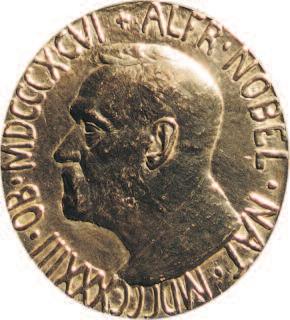

32 M A R S H A L L F
p h o t o c r e d t G e o r g e C M a r s h a l R e s e a r c h L b a r y
HHHHHHHH HHHHHHHH HHHHHHHH HHHHHHHH HHHHHHHH HHHHHHHH HHHHHHH HHHHHH HHHH HH H
i
u a d u a Marshal received this Nobel Peace Pr ze n 1953 I ’ s on d splay n our museum
n d v
d










